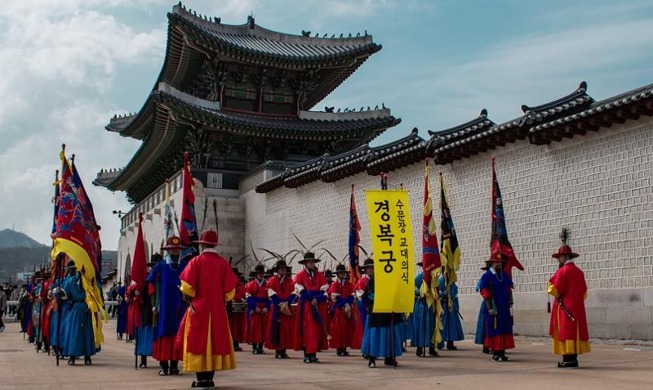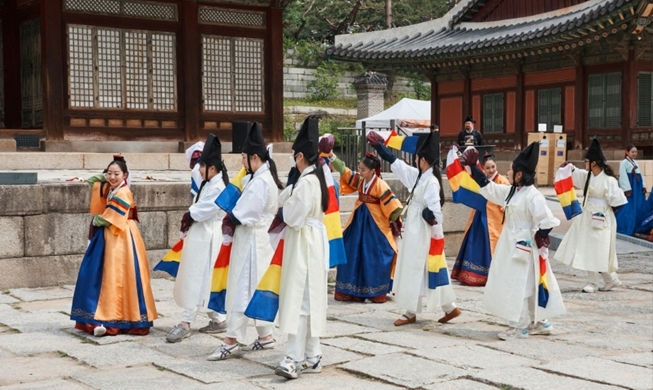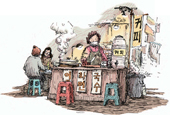-
 Korea.net's 24-hour YouTube channel
Korea.net's 24-hour YouTube channel- NEWS FOCUS
- ABOUT KOREA
- EVENTS
- RESOURCES
- GOVERNMENT
- ABOUT US
View this article in another language
- 한국어
- English
- 日本語
- 中文
- العربية
- Español
- Français
- Deutsch
- Pусский
- Tiếng Việt
- Indonesian
To tell the truth, street food in Korea is nothing new. On every corner and every street, you’ll find food stalls selling the new, the bizarre and the playful. All the food is designed to travel and you’ll often see high-heeled women walking with a hot dog on a stick or suited men standing next to a food stall to grab a quick bite. In Korea, this is the original fast food.
Korean street food is a wonderful fusion of creativity, culture, and mobility. Some of the foods, like braised silkworm larvae, are simply bizarre, while others are playful, such as the tornado potato: A whole potato cut to look like a spiral staircase. Others seem to have come straight out of the TV show MacGyver. The ColPop, for instance, is a soda cup with a bowl on top for a lid. Pieces of crispy fried chicken sit on top, so you can sip your soda and eat your chicken on the run. The Korean streets are a wonderland of interesting treats and you can eat three full meals (and between-meal snacks) on the go.
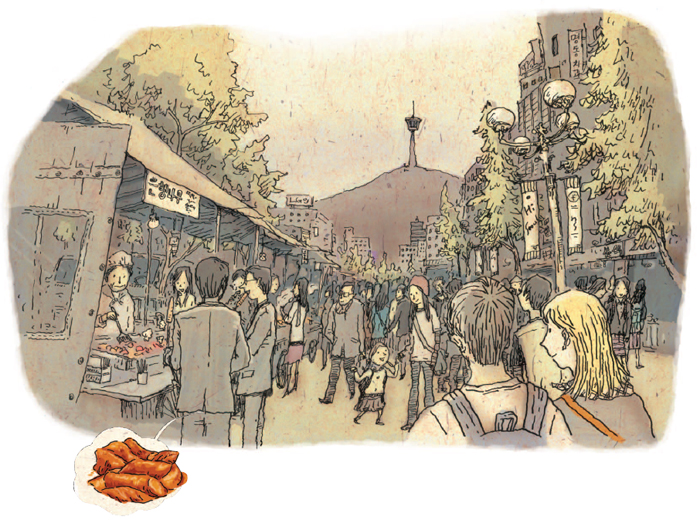
The avenues of Myeongdong, besides being rammed with shoppers, are awash with fabulous street carts. Here, you’ll find thick ribbons of fish cake skewered on long wooden poles and cooked in crab stock. You’ll see savory hamburger patties wrapped around chewy white rice cakes. And you’ll certainly smell the massive dried and smoked octopus tentacles that are sliced and grilled on heated black stones.
With so many of them fighting for the attention of passersby, street foods in Myeongdong have to make a statement. One of my favorite treats when I visit is the “dokkaebi hot dog,” a hot dog on a stick that is battered, fried and then studded with crinkled French fries. I ask one of the vendors what dokkaebi are and she explains that they are prankster demons who carry spiked clubs — not unlike the hot dog I am eating — which they bang on the ground to bring forth magical feasts or golden coins.
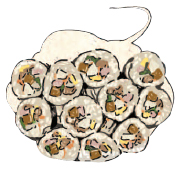
I take my demon club hot dog and continue down the road to find my next treat. These days, seemingly everything is available from street food vendors. As with the city’s restaurants, street foods are increasingly picking up foreign influences, with Myeongdong itself home to vendors selling kebabs, thirty centimeter-tall ice cream cones, hamburgers and much else besides.
After I finally finish my hot dog, though, I know just what I want next: ppopgi. Served on a popsicle stick, ppopgi is a lollipop that smells just like créme brulee. You’ll see old women squat on the ground as they heat up sugar in a small metal pot until it melts to a rich, caramel brown. Add a pinch of baking soda and the candy bubbles up and thickens. They’ll then put this sticky mixture on a board, flatten it, and stencil a shape such as a cloud, a star, or maybe a bird. Now, ppopgi isn’t just a food; it’s a game, too. If you can eat around the stenciled shape without breaking it, then the vendor will reward you with another ppopgi. I don’t succeed, but one was enough.
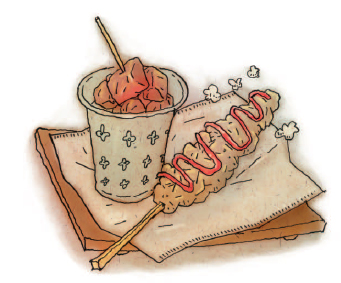
Later, as dinnertime approaches, I know I’m going to need something more substantial. Luckily, at just this moment, I draw near a street cart selling spicy rice cakes and fried snacks. Sauteed along with fish cakes in a spicy and sweet red chili paste sauce, these rice cakes are typically served along with your choice of battered, fried treats including sweet potato slices, dumplings, egg, noodle rolls and vegetable fritters. It’s all about the sauce with this streetside delicacy, so what I like to do is order a selection and have the vendor mix it up in the sauce. Yummy, very filling and cheap: only KRW 3,000 (USD 2.73).
In the evenings, tented food bars will open right on the edges of Seoul’s streets. One of the best places to experience this is over by Jongno 3-ga near the middle of town. Here, on most nights, the main drag will be lit up by a procession of orange tents and yellow lights.
There is something peculiarly enticing about sitting in these tents at night with friends. The conversations are more down to earth and personal. The foods you order there are made to accompany alcohol — typically soju, Korea’s best-known fire water, but sometimes milky rice wine (makgeolli) or beer. Soju is served in small glasses and throughout the evening everyone will propose continuous toasts and, more often than not, down the drink in one. It could be a toast of congratulations but often it is simply a toast of togetherness, of friendship. Koreans drink to build relationships and a sense of comfort — you’ll never see a Korean drink alone.
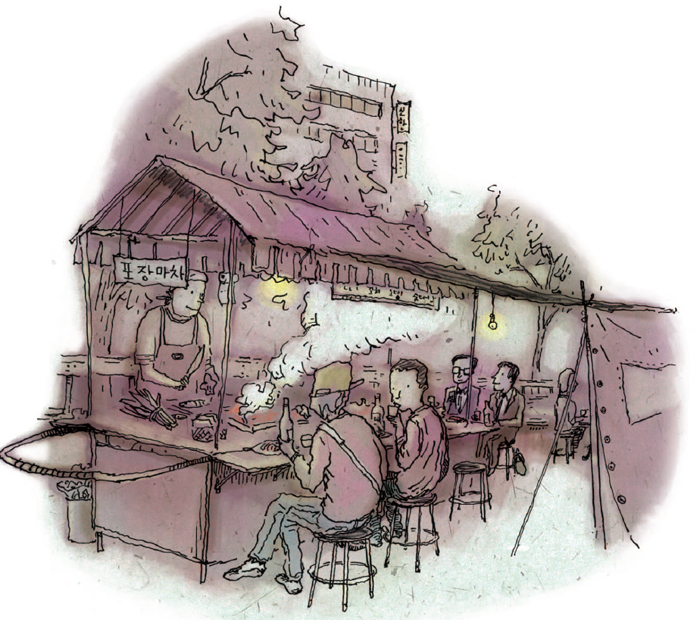
As I look around the tent, I can see people of all backgrounds united under one plastic roof. Next to me sits a group of elegantly dressed women in business attire, bottles of beer spread around their table. They are wearing clear plastic gloves and eating chili sauce-coated chicken’s feet (supposedly full of gelatin, which is good for your skin). Adjacent to them is a middle-aged couple in casual attire sitting across from a Korean man wearing a beret and, though night has fallen, sunglasses. A movie star, perhaps?
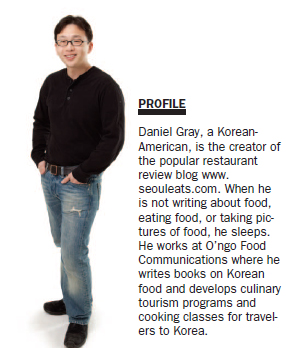
They have plates of rolled egg omelette dishes specked with small pieces of carrot and green onion with a drizzling of ketchup on top. The soju has already begun flowing, and three green bottles sit atop their small red plastic tabletop like emeralds on a royal carpet. Then, on the corner of the bench where my friend and I are eating, two older men, looking like they’ve just finished construction work, pull up a seat. Loud and boisterous, they seem on the verge of fighting each other, before their booming laughs clear the air. They sit and recount stories to one another as they take turns pouring white rice wine into little tin cups.
Inside this roadside tent, in the middle of the night, I feel like I am seeing the real Korea. When people ask me to tell them stories of life here, I will invariably talk about the street foods and the atmosphere in these tented restaurants. Just like the city that they and I call home, street foods here are fast, piquant and always on the go.
By Daniel Gray | photograph by Kim Nam-heon | illustrations by Jo Seung-yeon
*The series of columns written by expats is about their experiences in Korea and has been made possible with the cooperation with Korea Magazine.
Korean street food is a wonderful fusion of creativity, culture, and mobility. Some of the foods, like braised silkworm larvae, are simply bizarre, while others are playful, such as the tornado potato: A whole potato cut to look like a spiral staircase. Others seem to have come straight out of the TV show MacGyver. The ColPop, for instance, is a soda cup with a bowl on top for a lid. Pieces of crispy fried chicken sit on top, so you can sip your soda and eat your chicken on the run. The Korean streets are a wonderland of interesting treats and you can eat three full meals (and between-meal snacks) on the go.

The avenues of Myeongdong, besides being rammed with shoppers, are awash with fabulous street carts. Here, you’ll find thick ribbons of fish cake skewered on long wooden poles and cooked in crab stock. You’ll see savory hamburger patties wrapped around chewy white rice cakes. And you’ll certainly smell the massive dried and smoked octopus tentacles that are sliced and grilled on heated black stones.
With so many of them fighting for the attention of passersby, street foods in Myeongdong have to make a statement. One of my favorite treats when I visit is the “dokkaebi hot dog,” a hot dog on a stick that is battered, fried and then studded with crinkled French fries. I ask one of the vendors what dokkaebi are and she explains that they are prankster demons who carry spiked clubs — not unlike the hot dog I am eating — which they bang on the ground to bring forth magical feasts or golden coins.

I take my demon club hot dog and continue down the road to find my next treat. These days, seemingly everything is available from street food vendors. As with the city’s restaurants, street foods are increasingly picking up foreign influences, with Myeongdong itself home to vendors selling kebabs, thirty centimeter-tall ice cream cones, hamburgers and much else besides.
After I finally finish my hot dog, though, I know just what I want next: ppopgi. Served on a popsicle stick, ppopgi is a lollipop that smells just like créme brulee. You’ll see old women squat on the ground as they heat up sugar in a small metal pot until it melts to a rich, caramel brown. Add a pinch of baking soda and the candy bubbles up and thickens. They’ll then put this sticky mixture on a board, flatten it, and stencil a shape such as a cloud, a star, or maybe a bird. Now, ppopgi isn’t just a food; it’s a game, too. If you can eat around the stenciled shape without breaking it, then the vendor will reward you with another ppopgi. I don’t succeed, but one was enough.

Later, as dinnertime approaches, I know I’m going to need something more substantial. Luckily, at just this moment, I draw near a street cart selling spicy rice cakes and fried snacks. Sauteed along with fish cakes in a spicy and sweet red chili paste sauce, these rice cakes are typically served along with your choice of battered, fried treats including sweet potato slices, dumplings, egg, noodle rolls and vegetable fritters. It’s all about the sauce with this streetside delicacy, so what I like to do is order a selection and have the vendor mix it up in the sauce. Yummy, very filling and cheap: only KRW 3,000 (USD 2.73).
In the evenings, tented food bars will open right on the edges of Seoul’s streets. One of the best places to experience this is over by Jongno 3-ga near the middle of town. Here, on most nights, the main drag will be lit up by a procession of orange tents and yellow lights.
There is something peculiarly enticing about sitting in these tents at night with friends. The conversations are more down to earth and personal. The foods you order there are made to accompany alcohol — typically soju, Korea’s best-known fire water, but sometimes milky rice wine (makgeolli) or beer. Soju is served in small glasses and throughout the evening everyone will propose continuous toasts and, more often than not, down the drink in one. It could be a toast of congratulations but often it is simply a toast of togetherness, of friendship. Koreans drink to build relationships and a sense of comfort — you’ll never see a Korean drink alone.

As I look around the tent, I can see people of all backgrounds united under one plastic roof. Next to me sits a group of elegantly dressed women in business attire, bottles of beer spread around their table. They are wearing clear plastic gloves and eating chili sauce-coated chicken’s feet (supposedly full of gelatin, which is good for your skin). Adjacent to them is a middle-aged couple in casual attire sitting across from a Korean man wearing a beret and, though night has fallen, sunglasses. A movie star, perhaps?

They have plates of rolled egg omelette dishes specked with small pieces of carrot and green onion with a drizzling of ketchup on top. The soju has already begun flowing, and three green bottles sit atop their small red plastic tabletop like emeralds on a royal carpet. Then, on the corner of the bench where my friend and I are eating, two older men, looking like they’ve just finished construction work, pull up a seat. Loud and boisterous, they seem on the verge of fighting each other, before their booming laughs clear the air. They sit and recount stories to one another as they take turns pouring white rice wine into little tin cups.
Inside this roadside tent, in the middle of the night, I feel like I am seeing the real Korea. When people ask me to tell them stories of life here, I will invariably talk about the street foods and the atmosphere in these tented restaurants. Just like the city that they and I call home, street foods here are fast, piquant and always on the go.
By Daniel Gray | photograph by Kim Nam-heon | illustrations by Jo Seung-yeon
*The series of columns written by expats is about their experiences in Korea and has been made possible with the cooperation with Korea Magazine.




